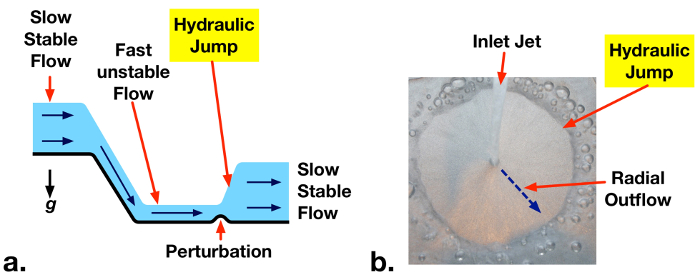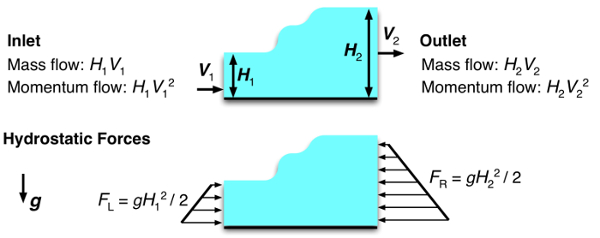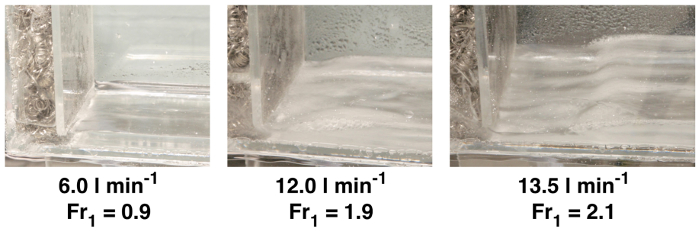液压跳跃
English
Share
Overview
资料来源: 亚历山大的贾斯汀和马赫迪。宾夕法尼亚州立大学机械与核工程系
当液体沿着明渠高速流动时, 水流会变得不稳定, 轻微的扰动会使液体上表面突然向更高的水平过渡 (图 1a)。这种急剧增加的液位称为水力跳跃。液位的增加会导致平均流速的降低。因此, 潜在的破坏性流体动能耗散为热。水力跃迁被故意地被设计入大水工作, 例如水坝溢洪道, 防止损伤和减少可能由快速的移动的小河造成的侵蚀。水力跃迁在河和小河也自然地发生, 并且可以被观察在家庭情况, 例如水的辐形流出从水龙头到水槽 (图 1b)。
在这个项目中, 将建立一个明渠流动实验设施。将安装一个闸门, 该闸门是可以升降的垂直闸门, 用来控制上游水库到下游溢洪道的水流流量。将测量在闸门出口处产生水力跃迁所需的流量。这些研究结果将与基于质量和动量分析的理论值进行比较。

图 1: a. 由于对不稳定的高速水流的轻微扰动, 从溢洪道下游发生的水力跃迁。水力跃迁的例子在水的辐形流出从家庭水龙头。
Principles
在宽阔的明渠水流中, 液体只被一个较低的固体边界所限制, 其上表面暴露在大气中。控制容积分析可以在明渠流量的一段上进行, 以平衡质量和动量的入口和出口运输 (图 2)。如果速度在控制音量 (V1和V2分别) 的入口和出口处具有相同的液体深度h1和h2, 则稳定的质量流量平衡减少到:
 (1)
(1)
此控制容积的x方向动量分析与入口和出口动量流率 (Eqn 2) 的静水压压力 (由于流体深度) 的作用力。压力作用力作用于控制容积的两侧, 并与液体的比重相等 (液体密度乘以重力加速度: ρg), 乘以每边的平均液体深度 (H1/2,H2/2), 乘以压力作用在每一侧的高度 (h1, h2)。这导致 Eqn 左侧的二次表达式2。动量流速通过每边 (Eqn. 2, 右边) 是相等的液体的质量流速通过控制容量 (在:, 出:) 乘以流体速度 (  v
v  1, v2)。
1, v2)。
 (2)
(2)
Eqn 1 可以替换为 Eqn 2 以消除V2。德数 () 也可以被替换, 这代表了流入流体动量与静力的相对强度. 生成的表达式可以表示为:
生成的表达式可以表示为:
 (3)
(3)
这个立方方程有三解。一个是 H1 = H2, 给正常开放渠道行为 (入口深度 = 出口深度)。第二个解决方案给出了一个负的液位, 这是物理, 可以消除。剩下的解决方案允许增加深度 (水力跃迁) 或减少深度 (水力消沉), 根据入口德数字。如果入口德数 (Fr1) 大于 1, 则该流称为超临界 (不稳定) 并且具有较高的机械能 (动能 + 引力势能)。在这种情况下, 水力跃迁可能形成自发地或由于对流动的一些干扰。水力跃迁将机械能转化为热能, 大大降低了动能, 并略微增加了流动的势能。所产生的出口高度由 Eqn 4 (Eqn. 3 的解决方案) 给出。如果 Fr1 > 1, 因为它会增加流动的机械能, 违反热力学第二定律, 就无法发生液压凹陷。
 (4)
(4)
水力跃迁的力量增加与入口德数字。当 Fr1增加时, h2/h1的大小会增加, 而入口动能的较大部分则作为热 [1] 消散。

图 2: 包含液压跃迁的明渠水流段的控制容积。指出了每单位宽度的进、出质量和动量流率。每个单位宽度的静水压力在下图中表示。
Procedure
Results
Upstream Froude numbers (Fr1) and measured and theoretical downstream depths are summarized in Table 1. The measured threshold inlet flow rate for formation of a hydraulic jump corresponds to Fr1 = 0.9 ± 0.3, which matches the theoretical value of 1. At supercritical flow rates (Fr1 > 1) predicted downstream depths match theoretical values (Eqn. 4) within experimental uncertainty.
Table 1 – Measured upstream Froude numbers (Fr1) and downstream liquid depths for H1 = 5 ± 1 mm
| Liquid Flow Rate
( |
Upstream Froude Number (Fr1) | Measured Downstream Depth (H2) | Predicted Downstream Depth (H2) | Notes |
| 6.0 ± 0.5 | 0.9 ± 0.3 | 5 ± 1 | 5 ± 1 | Threshold Froude number for hydraulic jump |
| 11.0 ± 0.5 | 1.7 ± 0.5 | 11 ± 1 | 10 ± 2 | |
| 12.0 ± 0.5 | 1.9 ± 0.6 | 12 ± 1 | 11 ± 2 | |
| 13.5 ± 0.5 | 2.1 ± 0.6 | 14 ± 1 | 13 ± 2 |
Photographs of the hydraulic jumps from the above cases are presented in Fig. 4. No jump is observed for  = 6.0 l min-1 (Fr1 = 0.9). Jumps are observed for the two other cases with Fr1 > 1. A stronger, higher amplitude, jump is observed at the higher flow rate supercritical case.
= 6.0 l min-1 (Fr1 = 0.9). Jumps are observed for the two other cases with Fr1 > 1. A stronger, higher amplitude, jump is observed at the higher flow rate supercritical case.

Figure 4: Photograph of hydraulic jumps, showing critical condition (no jump, Fr1 = 0.9) and jumps at Fr1 = 1.9, 2.1.
Applications and Summary
This experiment demonstrated the phenomena of hydraulic jumps that form at supercritical conditions (Fr > 1) in open channel flows. An experimental facility was constructed to observe hydraulic jump phenomena at varying flow rates. Downstream liquid depths were measured and matched with theoretical predictions.
In this experiment, the maximum reported inlet Froude number was 2.1. The pump was rated to deliver significantly higher flow rates, but resistance in the flow meter limited measurable flow rates to ~14 l min-1. In future experiments, a pump with a greater head rating or a lower pressure drop flow meter may enable a broader range of studied conditions.
Hydraulic jumps are often engineered into hydraulic systems to dissipate fluid mechanical energy into heat. This reduces the potential for damage by high velocity liquid jetting from spillways. At high channel flow velocities, sediment can be lifted up from streambeds and fluidized. By reducing flow velocities, hydraulic jumps also reduce the potential for erosion and scouring around pilings. In water treatment plants, hydraulic jumps are sometimes used to induce mixing and aerate flow. The mixing performance and gas entrainment from hydraulic jumps can be observed qualitatively in this experiment.
For all of these applications, momentum analyses across hydraulic jumps, as discussed here, are key tools for predicting hydraulic system behavior. Similarly, scale model experiments such as those demonstrated in this project, can guide the design of open-channel flow geometries and hydraulic equipment for large-scale engineering applications.
References
- Cimbala, Y.A. Cengel, Fluid Mechanics Fundamentals and Applications, 3rd edition, McGraw-Hill, New York, NY, 2014.
Transcript
A hydraulic jump is a phenomenon that occurs in fast-moving open flows when the flow becomes unstable. When a jump occurs, the height of the liquid surface increases abruptly resulting in an increased depth and decreased average flow velocity downstream. An important side effect of this phenomenon is that much of the kinetic energy in the upstream flow is dissipated as heat. Although hydraulic jumps often arise naturally, such as in rivers or the flow into a household sink, they are also purposely engineered into large waterworks to minimize erosion, or increase mixing. This video will illustrate the principles behind hydraulic jumps in a straight channel and then demonstrate the phenomenon experimentally using a small-scale open channel flow facility. After analyzing the results, some applications of hydraulic jumps will be discussed.
Consider the flow in a wide, straight section of an open channel where a hydraulic jump occurs and construct a control volume on a sluice around the jump. If the flow velocity is uniform at the inlet and outlet, conservation of mass yields a simple relation between upstream and downstream fluid depths. Depth multiplied by velocity is constant. A second relation can be found by considering conservation of momentum. Mass transported across the input and output carries momentum with it equal to the corresponding mass flux multiplied by the flow velocity. Hydrostatic forces on the surface of the control volume also contribute to the momentum balance and must be included. These forces are equal to the average pressure on the surface multiplied by the area. At this point, it is useful to introduce the Froude number, a dimensionless quantity named after the English engineer and hydrodynamicist, William Froude. The Froude number characterizes the relative strength of fluid momentum to hydrostatic forces. Now, if the momentum relation is rewritten in terms of the Froude number, with the output velocity eliminated by substitution using the mass relation, the result is a cubic equation in terms of the ratio of downstream and upstream depths. This equation can be simplified by factoring out the trivial solution where the upstream and downstream depths are equal. The two remaining solutions are easily found using the quadratic equation, but the negative solution can be eliminated since it is non-physical. The remaining solution corresponds to an increase in depth, a hydraulic jump, or a decrease in depth, a hydraulic depression, based on the value of the upstream Froude number. If the upstream Froude number is greater than one, the flow has a high mechanical energy and is supercritical or unstable. A hydraulic depression cannot form in this regime because it would increase mechanical energy and violate the second law of thermodynamics. On the other hand, a hydraulic jump can form, either spontaneously or due to some disturbance in the flow. An input Froude number of one represents the minimum threshold for the onset of a hydraulic jump. Hydraulic jumps dissipate mechanical energy into heat, and significantly reduce the kinetic energy, while slightly increasing the potential energy of the flow. As the Froude number increases, so does the ratio of downstream to upstream depths and the amount of kinetic energy dissipated as heat. Now that we understand the principles behind hydraulic jumps, let’s examine them experimentally.
First, fabricate the open channel flow facility as described in the text. The facility has an upper and lower reservoir connected by an open channel. Water pumped from the lower reservoir is deposited in the upper reservoir with the flow rate controlled and measured by a valve and flow meter in line with the pump. Steel wool in the upper reservoir helps to evenly distribute the water across the width of the section, and the adjustable sluice gate controls the fluid depth as it enters the channel. After flowing through the channel, the fluid is deposited back into the lower reservoir. When the flow facility is assembled, set it up on a bench and remove any nearby electronic devices. Plug the pump into a GFCI outlet to minimize the risk of electrical shock, and then fill the lower reservoir with water. You are now ready to perform the experiment.
Adjust the sluice gate to approximately five millimeters. Measure the final height of the gap underneath the sluice gate using a ruler, and record this distance as the upstream flow depth, H1. When you are finished, turn on the pump and use the valve to maximize the flow rate without exceeding the scale on the flow meter. Use the ruler again to measure the fluid depth after the hydraulic jump. Record the flow rate, along with this second distance which is the downstream flow depth, H2. Before continuing, observe the shape of the hydraulic jump. You should notice larger, more abrupt transitions for higher flow rates, and smaller, more gradual transitions for lower flow rates. Now, repeat your measurements and observations for successively lower flow rates. Try to determine the minimum threshold flow rate for the formation of a hydraulic jump. Once you have found the threshold flow rate, you are ready to analyze the results.
For each volumetric flow rate, you should have a measurement of the downstream fluid depth. The upstream depth is the same for all cases. Complete the following calculations for each measurement and propagate uncertainties along the way. First, determine the inlet flow velocity. Divide the volumetric flow rate by the channel width and upstream depth. Next, evaluate the upstream Froude number using the definition given before, and substituting in the acceleration due to gravity, as well as the upstream height and velocity. Now, use the Froude number and the non-trivial solution for the jump height to calculate the theoretical downstream depth. Compare the theoretical prediction with the measured downstream depth. At supercritical flow rates, the predictions match the measured depths within experimental uncertainty. Look at your results for the threshold flow rate. Within experimental uncertainty, the Froude number is one, as we anticipated from the theoretical analysis. The rate of mechanical energy loss through the hydraulic jump can also be calculated from these data. First, calculate the mechanical energy of the fluid flowing into the jump, which is the sum of kinetic and potential energy flow rates at the inlet. Now, determine the output energy rate in the same way, but with values at the outlet. The rate of mechanical energy dissipation to heat is the difference between the input and output rates. In this experiment, the energy loss rate can reach about 40% of the inlet energy, or higher. These results highlight the effectiveness of momentum analyses and scale model experiments for understanding and predicting the behavior of hydraulic systems. Now let’s look at some other ways hydraulic jumps are utilized.
Hydraulic jumps are an important natural phenomenon with many engineering applications. Hydraulic jumps are often engineered into hydraulic systems to dissipate fluid mechanical energy into heat. This reduces the potential for damage by high velocity liquid jetting from spillways. At high channel flow velocities, sediment can be lifted up from streambeds and fluidized. By reducing flow velocities, hydraulic jumps also reduce the potential for erosion and scouring around pilings. In water treatment plants, hydraulic jumps are sometimes used to induce mixing and aerate flow. The mixing performance and gas entrainment from hydraulic jumps can be observed qualitatively in this experiment.
You’ve just watched JoVE’s introduction to hydraulic jumps. You should now understand how to use a control volume approach to predict the flow behavior, and how to measure this behavior using an open channel flow facility. You’ve also seen some practical uses for engineering hydraulic jumps in real applications. Thanks for watching.
